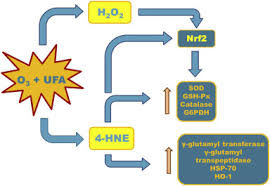Use of Ozone Gas in the Treatment of Reproductive Problems in Large Animals
Compiled & Edited by-Dr.Rk Singh
INTRODUCTION
Ozone (O3) is gas and it has potent oxidant properties, it exerts damaging effects on microbes and has been used for decades as a therapy. The disinfectant activity of O3 is widely used. Ozone is an elemental form of oxygen occurring naturally in the Earth’s atmosphere. It surrounds the earth at an altitude of 50 000 to 100 000 feet. Ozone, in its gaseous state, is toxic to the human tissues. In aqueous form, however, it may have therapeutic effects. Ozone was first discovered by the German chemist Christian Frederick Schonbein in the year 1840 in the University of Basel in Switzerland. Ozone was used for the first time to disinfect operating rooms in 1856 and subsequently for water treatment in 1860 (Foundation for alternative science & Technology). The German Army used ozone to treat battle wounds and other infections during World War I.
Mechanism of action
Ozone contains three oxygen atoms, which react in the tissue as it breaks down to ordinary oxygen (O2) and a reactive singlet oxygen molecule that can combine with chemicals and other molecules. Free from side effects, this is an extremely safe therapy that works in a number of ways by:
- Decreasing inflammation. When you have inflammation, swelling, bruising, infection, cancer and trauma to the tissue, there are higher amounts of carbon dioxide within the tissue. This increase of carbon dioxide contributes to inflammation and pain. Increasing the amount of oxygen delivered to the tissue in the form of reactive ozone decreases inflammation, pain and swelling, and helps increase healing.
- Activating the immune system. Ozone therapy has also been shown to activate the immune system by stimulating cytokine production. Cytokines are “messenger cells”, such as interferons and interleukins, which “set off a cascade reaction of positive changes throughout the immune system.”(t). Ozone also promotes the production of antioxidant enzymes; glutathione peroxidase, catalase, reductase and super-oxide dismutase, the enzymes forming the cell wall coating; thereby enhancing cellular immunity.
- Inactivating bacteria, viruses, fungi, yeast and protozoa. Healthy cells are surrounded by an enzyme coating, which ozone does not penetrate, but bacteria and viruses have no such coatings. Ozone therapy disrupts the integrity of the bacterial cell envelope through oxidation of the phospholipids and lipoproteins (peroxidation). In viruses, this peroxidation disrupts the reproductive cycle and damages the viral capsid. In fungi, ozone inhibits cell growth. Ozone gas has the remarkable curing rates in the following reproductive diseases.
Therapy on Reproductive Problems
The uterus of a cow with retention of fetal Membrane is overpopulated with bacteria and endometrium defense is reduced due to the diminished functional ability of neutrophils. This increases the risk of development of inflammation of the uterus. The efficacy of intrauterine administration of antibiotics has been questioned due to the multiple interactions of the antibiotic substances with uterine contents and varying degrees of absorption Administration of antibiotics results in a high risk for residues in milk, especially with extra-label use of drug administration. Intrauterine ozone treatment of retained fetal membrane results in the improvement of reproductive performance in terms improvement in interval calving, increase relative pregnancy rate (%) and service conception rate. Intrauterine ozone administration, which was provide a potent antimicrobial activity for a wide range of microorganisms. Ozone also increases host immunity by activating erythrocyte metabolism and local tissue immune response. Thus, it leads to micro-environmental healing and provide a cure in undiagnosed metritis cases also.
Therapy on Mastitis
Both clinical and sub-clinical, is the most important disease of dairy cattle, which causes billions of dollars of economic losses annually. The infusion of 50 ml Ozone gas into the inflamed quarter via the teat canal for 3 days results in reduction of the number of somatic cell count.
Researchers are currently treating the diseases with different forms of ozone on abscesses, acne, AIDS, allergies, anal fissures, arthritis, asthma, cancerous tumors, cerebral sclerosis, circulatory disturbances, cirrhosis of liver, constipation, corneal ulcers, cystitis, decubitus ulcers (bedsores), diarrhea, fungal diseases, gangrene, gastroduodenal ulcers, glaucoma, hepatitis, herpes simplex and zoster, hypercholesterolemia, osteomyelitis, Parkinson’s disease, Raynaud’s disease, rheumatoid arthritis, senile dementia, sepsis, sinusitis, spondylitis, thrombophlebitis, wound healing and others.
Rectal applications of Ozone insufflations are a powerful adjunct to the treatment of both infectious and noninfectious diseases of the digestive tract. Ozone is effective in reducing intestinal parasites (helminths), viruses and rickettsiae (Rotavirus and Ehrlichia in horses), bacteria (E. coli, Salmonella spp., Rhodococcus, Corynebacterium equi in horses), protozoa and fungi (Eimeria spp. and Aspergillus fumigatus in horses) and algae (Prototheca spp.). Ozone is effective in diarrhea and inflammatory bowel disease of horses. Vaginal ozone insufflations are effective against vaginal Candidiasis (Vaginitis, Equine Coital Exanthema (EHV-3). These treatments of Ozone gas may be the source of awareness to progressive farmers in developing countries.
Reference-On Request.


